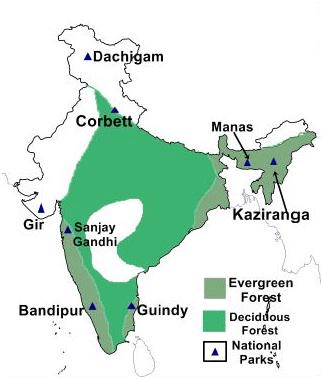NCERT Solutions Class 9 Social Science (Geography – Contemporary India – I)
The NCERT Solutions in English Language for Class 9 Social Science (Geography – Contemporary India – I) Chapter – 5 (Natural Vegetation and Wildlife) has been provided here to help the students in solving the questions from this exercise.
Chapter – 5 (Natural Vegetation and Wildlife)
1. Choose the right answer from the four alternatives given below:
(i) Which of the following types of vegetation does rubber belong to?
(a) Tundra
(b) Himalayan
(c) Tidal
(d) Tropical Evergreen
Answer – (d) Tropical Evergreen
(ii) Cinchona trees are found in areas of rainfall more than
(a) 100 cm
(b) 70 cm
(c) 50 cm
(d) less than 50 cm
Answer – (a) 100 cm
(iii) In which of the following state is the Simlipal bio-reserve located?
(a) Punjab
(b) Delhi
(c) Odisha
(d) West Bengal
Answer – (c) Odisha
(iv) Which one of the following bio-reserves of India is not included in the world network of bio reserves?
(a) Manas
(b) Gulf of Mannar
(c) Nilgiri
(d) Nanda Devi
Answer – (a) Manas
2. Answer the following questions briefly.
(i) What factors are responsible for the distribution of plants and animals in India?
Answer – Factors responsible for the distribution of plants and animals in India are:
(a) Relief: Land and soil
(b) Climate: Temperature, Humidity, Photoperiod and Precipitation.
(ii) What is a bio-reserve? Give two examples.
Answer – Bio-reserves are protected areas. This is done to protect natural vegetation, wildlife and the environment.
Examples: – Sunderbans, Gulf of Mannar
(iii) Name two animals having habitats in the tropical and montane types of vegetation.
Answer – Tropical animals: Tiger, Elephant
Montane animals: Snow Leopard, Spotted dear
3. Distinguish between
(i) Flora and Fauna
Answer – Difference between Flora and Fauna.
| Flora | Fauna |
| Flora refers to the natural vegetation developing in a particular area. |
Fauna refers to the wildlife living in a particular area. |
| On the earth it was the first form of life that appeared. | After the appearance of flora this fauna was appeared because of being their heterotrophs. |
| To convert the solar energy into food it is used because of its ability to do so. | Its survival depends upon the flora. |
(ii) Tropical evergreen and deciduous forests
Answer – Difference between Tropical Evergreen and Deciduous Forests.
| Tropical Evergreen Forests | Tropical Deciduous Forests |
| They are called rainforests. | They are called monsoon forests. |
| No definite time for trees to shed leaves. | Trees shed leaves for about six to eight weeks in the dry summer. |
| Rainfall is more than 200 cm. |
The rainfall range is between 200 cm to 70 cm. |
4. Name different types of vegetation found in India and describe the vegetation of high altitudes.
Answer – The different types of vegetation found in India are listed below:
- Tropical evergreen forests
- Tropical deciduous forests
- Tropical thorn forests and scrubs
- Montane forests
- Mangrove forests
The characteristics of vegetation in high altitudes are as follows:
- Alpine vegetation is found in altitudes above 3600 m.
- Trees in these areas are junipers, birches and pines.
5. Several species of plants and animals are endangered in India. Why?
Answer – The reasons are as follows:
- Increasing population
- Pollution
- Deforestation
- Hunting by poachers.
6. Why has India a rich heritage of flora and fauna?
Answer – India has a rich heritage of flora and fauna due to following reasons:
- India is a country with diverse relief features.
- Availability of different types of soil.
- Variation in climatic conditions.
MAP SKILLS
On an outline map of India, label the following.
(i) Areas of Evergreen Forests.
(ii) Areas of Dry Deciduous Forests.
(iii) Two national parks each in Northern, Southern, Eastern and Western parts of the Country.
Answer –


Leave a Reply